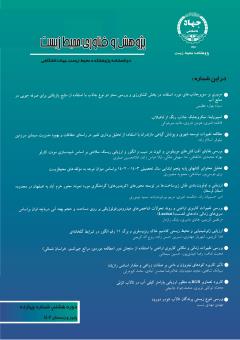تحلیل محتوای کتابهای پایه پنجم ابتدایی سال تحصیلی 1403-1402 براساس میزان توجه به مؤلفههای محیطزیست
محورهای موضوعی : Environmental Education
پری مو سی پور میاندهی
1
![]() ,
محبوبه منصوری
2
,
محبوبه منصوری
2
1 - استادیار، گروه آموزش جغرافیا، دانشگاه فرهنگیان، صندوق پستی889-14665، تهران، ایران
2 - آموزگار ابتدایی، آموزش و پرورش، لنگرود، ایران
کلید واژه: کتاب, تحلیل محتوا, مؤلفه های محیط زیست , پنجم ابتدایی ,
چکیده مقاله :
پژوهش حاضر با هدف تحلیل محتوای کتاب های پایه پنجم ابتدایی براساس میزان توجه به مؤلفهای محیط زیستی انجام شده است. روش پژوهش توصیفی که از روش تحلیل محتوا به صورت کیفی، کمی انجام شده است. جامعه آماری، کتابهای پایه پنجم دوره ابتدایی در سال تحصیلی 1403 - 1402 است. در این کتابها، متن، پرسش و تصویرها تحلیل شده است. در این مطالعه 9 مؤلفه محیط زیستی که شامل، آب، هوا، آب و هوا، خاک، صوت، گیاهان، جانوران، زباله و آلودگی بررسی شده است. بر اساس یافتههای پژوهش کتابهای مورد تحلیل از بین مؤلفههای محیط زیستی، 779 بار به آب، 145 بار به هوا، 52 بار به آب و هوا، 355 بار به خاک، 54 بار به صوت، 991 بار به گیاهان، 351 بار به جانوران، 34 بار به آلودگی و 8 بار به زباله توجه شده است. مؤلفه گیاهان با فراوانی 991 در رتبه اول و مؤلفه زباله با فراوانی 8 در رتبهی آخر هستند. نتایج نشان میدهد توجه به تعدادی و نادیده گرفتن مولفههای دیگر موجب اختلال در ایجاد دانش و رفتار محیط زیستی دانش آموزان میشود. همچنین، در این کتابها به تأثیرات مثبت و منفی انسان بر محیط زیست اشاره نشده است. دانشآموزان بهعنوان شهروندان جامعه و آیندهسازان باید از نتیجهی رفتار خود و دیگران با محیط زیست آگاه باشند تا بتوانند در جهت کاهش رفتار نامطلوب و افزایش رفتار مطلوب محیط زیستی گام بردارند.
The current research was conducted with the aim of analyzing the content of fifth grade books based on the level of attention to environmental components. Descriptive research method has been done qualitatively and quantitatively by content analysis method. The statistical society is the books of the fifth grade of the elementary school in the academic year 2023-2024. In these books, text, questions and pictures have been analyzed. In this study, 9 environmental components including water, air, climate, soil, sound, plants, animals, waste and pollution were investigated. According to the research findings, among the environmental components, attention has been paid 779 times to water, 145 times to air, 52 times to climate, 355 times to soil, 54 times to sound, 991 times to plants, 351 times to animals, 34 times to pollution and 8 times to waste. The plant component with a frequency of 991 is in the first rank and the waste component is in the last rank with a frequency of 8. The results show that paying special attention to a number of components and ignoring the others, causes disturbances in creating students' environmental knowledge and behavior. Also, the positive and negative effects of humans on the environment are not mentioned in these books. As citizens of the society and future makers, students should be aware of the result of their behavior and others with the environment so that they can take steps reducing the undesirable behavior and increasing favorable environmental behavior.
